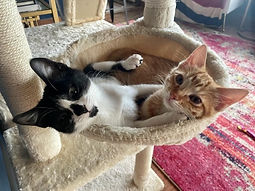
Events & More

CAMP's PET GALA
Wednesday, October 23
SmogShoppe, Culver City
6:30-10:00pm
Join CAMP at our inaugural Pet Gala for a magical masquerade evening celebration marking 300,000 spayed and neutered cats and dogs. Be a part of the kick off of our capital campaign, and help us raise needed funding to continue providing equitable veterinary care, community resources and education in Los Angeles.
ONLINE AUCTION
October 16 - 23
Be a pet hero and support the Pet Gala! Everyone is invited to participate in our online auction, even if you cannot attend the event. Check back regularly as new items are added daily.
Get Ready for the PET GALA!
Join us for a masquerade affair beyond compare!
Cocktails • Dinner • Celebration
Featuring special Pioneer Award honorees:
Dr. Gary K. Michelson and Alya Michelson
&
Robert and Erika Brunson Fund
VIP Guest
Jackson Galaxy
Celebrity Host
Hunter March
.png)
🐾 In support of CAMP, bringing affordable and accessible veterinary care to pets & their people
*Festive Masquerade Attire Encouraged!
-
6:00 pm - VIP reception
-
6:30 pm - Cocktails, Hors d'oeuvres, Live Music, Pet Communicator, Mask Making Bar, Silent Auction and more!
-
7:30 pm - Dinner & Honoree Presentation
-
9:00 - Dessert & Dancing
About our Esteemed Honorees
The Robert and Erika Brunson Fund
Robert and Erika Brunson have been trailblazers in animal welfare for over 50 years, funding numerous life-saving efforts including SPAY4LA, a mobile clinic providing high-quality spay/neuter surgeries and low-cost vaccines in Los Angeles. Their work, in partnership with Michelson Found Animals, has saved thousands of animals’ lives. Erika was a pioneer, serving as a commissioner on the Los Angeles Board of Animal Regulation and founding the Coalition for Pets & Public Safety. She played a crucial role in increasing spay/neuter procedures to combat overpopulation and reduce euthanasia rates.
In 2003, Los Angeles shelters euthanized 30,000 animals annually due to unchecked breeding and lack of spay/neuter resources. Dr. Gary K. Michelson created a network of low-cost clinics, supported by Michelson Found Animals' $11 million in grants, to address this crisis. Thanks to these efforts, the save rate for dogs in LA City shelters has been over 90% for several years. The Robert & Erika Brunson Fund, established to honor their legacy, continues to support animal welfare and ensure animals are placed in loving homes.
Dr. Gary K. Michelson and Alya Michelson
Dr. Gary Michelson and Alya Michelson are a dynamic husband/wife duo whose life focus is on their philanthropy and helping to benefit people, pets and our planet. Dr. Gary K. Michelson started the Michelson Found Animals Foundation in the aftermath of Hurricane Katrina, establishing the first free pet microchip registry to help every lost pet find their way home. In the 15 years since, Found Animals has identified important problems facing pets and people and developed real-world, scalable solutions to help them thrive. Awarding the historic $1 Million Grant to CAMP on World Spay Day in support of the build out of CAMP’s new South Los Angeles clinic is just one of an endless number of ways they have bolstered the community. Please see their official bios to learn about their vast contributions to society.
https://www.garykmichelson.org/biography
https://www.alyamichelson.org/biography
About SmogShoppe (event venue)
The Pet Gala is being held at the the uniquely beautiful SmogShoppe - an indoor-outdoor venue in the heart of Culver City’s Arts District. Once a smog check center, the venue is now a 100% solar-powered haven teeming with vertical gardens, desert plants and vintage furnishings.—the perfect special spot to hold CAMP's inaugural Pet Gala!
Sponsorship Packages
Become an inaugural sponsor of the Pet Gala, and your impact will be felt for years to come.
Sponsorship benefits include: Marketing Reach | Preferred Seating | VIP Experience | Special Giveaways | Helping Pets
More Ways to Help
-
Unable to attend? You can still donate to support CAMP HERE!
-
We also are soliciting items to include in our exciting SILENT AUCTION. Sign up HERE!


![PetSpace_Horizontal_RGB[97].png](https://static.wixstatic.com/media/9738fa_e0f873bc1c2043b382908fd8b774d38a~mv2.png/v1/fill/w_317,h_110,al_c,q_85,usm_0.66_1.00_0.01,enc_avif,quality_auto/PetSpace_Horizontal_RGB%5B97%5D.png)
%20copy%203.png)

















%20(1).png)
.png)












.jpg)






















.jpg)